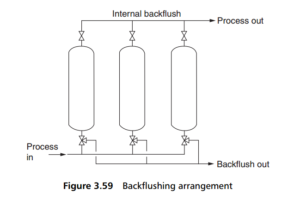0
-
An empty cart
You have no item in your shopping cart
envato-wordpress-toolkit domain was triggered too early. This is usually an indicator for some code in the plugin or theme running too early. Translations should be loaded at the init action or later. Please see Debugging in WordPress for more information. (This message was added in version 6.7.0.) in /var/www/wp-includes/functions.php on line 6121g5plus-darna domain was triggered too early. This is usually an indicator for some code in the plugin or theme running too early. Translations should be loaded at the init action or later. Please see Debugging in WordPress for more information. (This message was added in version 6.7.0.) in /var/www/wp-includes/functions.php on line 6121The most common form of cleaning is to reverse the flow of fluid through the filter medium, and so to blow the surface clear of collected contaminants. As this requires filtration to stop, a satisfactory system employs at least two filters, side by side in a duplex arrangement, with the piping and valves around the filters such that the main flow can be switched from one filter to the other when full of dirt, after which the dirty filter is backflushed to wash all of the collected contaminants off the filter element. Figure 3.59 shows such an arrangement, but with three elements.

The backflushing can be described as internal when some of the filtrate is redirected for the washing duty (as in Figure 3.59), and external when a fluid other than the filtrate is used as the backflush agent. A combination of fluids may be used as the backwash, and these may include compressed air. In some applications, it is necessary to use compressed air to complete the cleaning of the element.
Cartridge backflushable filter systems, with suitable elements, can be used to filter a wide range of liquids, from water to various chemicals, including toxic materials. They are essentially polishing filters with a low dirt-holding capacity. Hence
they should only be used where the contaminant loading is under 1000 ppm. While higher contaminant loadings could theoretically be handled, other types of filtration system or solid-liquid separation method would normally offer more economical alternatives.
Backflushable filters generally rely on the liquid velocity to clean the filter medium. This usually limits the use of these systems to low viscosity liquids (up to 50cp). While this is generally true, there are applications where backflushable systems operate very well with fluid viscosity as high as 50,000cp. In these cases, fluid velocity is almost certainly not a major factor in cleaning the filter medium.
Cartridge backflushable systems operate as closed systems. As a consequence, they can be used in applications with toxic or hazardous fluids with a minimum impact on the environment.
Contaminant loading considerations manifest themselves in their effects on the filter area required, the interval between backflushes, and the type of backflush system (internal or external) that is needed. The minimum practical interval between
backflush cycles must be at least long enough as to permit every filter to be backflushed, plus allowing for any abnormally high contaminant loading. There is also an actual dirt-holding capacity for the particular liquid/contaminant combination.
In addition, there is also a backflushing efficiency involved, which is a function of the liquid/contaminant combination, the backflush flow rate and other factors. These parameters all combine to give an expression for estimating the filter area:

This relationship then gives the area required in terms of the number of square metres required for one hour of operation.
The area that is determined in this way is only an estimate since some of the parameters used in the above equation are also estimates (dirt-holding capacity and backflushing efficiency). The main ramification of this is that the backflush interval
achieved will be different to some degree from that calculated. In some cases, it is worthwhile to refine the basic data used in the equation by recognizing that the actual dirt-holding capacity is usually affected by the forward flow rate, and that the backflush interval can be corrected to account for the on-stream exposure of most filters during a backflush cleaning cycle.
Where a combination of liquid and gas is used to backflush, a blast of gas is introduced to dislodge the contaminant and then a liquid stream is used to flush the contaminant out of the system. When this approach is used, some relief may be obtained in the reverse pressure and flow requirements for satisfactory cleaning. There is no simple formula that can then be used to optimize the system, primarily because the particular installation frequently imposes design restraints unique to that installation.
A backflushable cartridge system must be sized taking into account both pressure and contaminant loading limitations. Basically the pressure considerations involve ensuring that the system has enough reverse pressure to adequately clean itself and that the system will operate effectively within the pressure constraints of the installation. The reverse pressure drop across the filter medium should be at least equal to, or as much as twice, the maximum forward pressure drop. This requirement usually causes the most concern in an internal backflush system, because the process outlet pressure, which is
also the backflush fluid inlet pressure, is lowest when backflush cleaning has to be initiated. In addition, it is usually true of any multi-vessel backflushed system that the forward pressure drop increases to a maximum when the first vessel is taken off stream.
The backwashing process can quite easily be automated, by means of electropneumatically operated control valves managed by a dedicated programmed logic controller. Any reasonable backflush interval can be set into the system, and can then be adjusted in the light of operating experience.
Ask for more information, please click here.